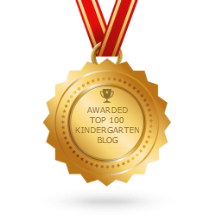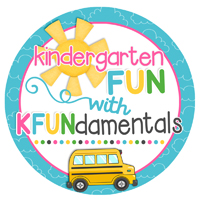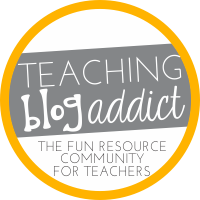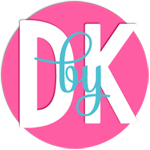Playing To Learn:
We have all read the research on how play is an important part of learning and how children need to get up and move during their school day. That is why I have incorporated "play time" or "center time" into our daily routine.
Twice a day, each child has from 10 to 30 minutes each day to explore and interact with the varied centers. They are given 1hr. & 20 min to complete quality table work, meet with me in a small group setting for 25 min, and meet for intervention or enrichment with my assistant for 25 min each day. Their table work should take them about 20 minutes to complete, so they can have up to 30 minutes at the centers twice a day, so that's 60 min/day.
What About The Exceptions:
We all have students who work slowly. I have scheduled time, after I teach my small group lessons, to help those students in tiny groups of maybe 2-4 to stay focused and complete their work. My assistant and parent volunteers (if I have any) assist in this same way. Our goal is to encourage quality with speed so everyone gets at least ten minutes to play.
How To Create Great Centers: (on a dime)
I have been teaching for 36 years, so I have a lot of "stuff", but you can take an idea from each of these centers and make it your own. Before I had a painting easel, I stapled a clear plastic table cloth to a small bulletin board and set paints up for students to use. And you don't need ALL of these centers. Just take the ideas you like and have FUN! (I have included the skills for each center so you can post them by each center to help explain the value of play to anyone who happens to visit your classroom.)
Painting Easel: I bought this with money I received from a grant I wrote. Students may paint only one painting each day. Skills: Fine motor. Also, students can paint something from science (things that sink or float), letters & numbers, or the current season.
 |
| Wet sponges keep the paints from drying out. |
Big Books: I have a rack filled with big books. 1 or 2 students may take one to the rug to read, re-tell, or just explore. We all have big books. Why not let the kids use them every day instead of storing them for teacher use only? Skills: Concepts of print (front & back of book), picture walk, reading, re-telling the story.)
Class Library: I added stuffed animals that go
with books (like Clifford & Corduroy) and some cute furniture that I bought with grant money from a grant I wrote. The books we write as a class are in the library too. I number the pages with each students class number & I include a numbered class list as the Table Of Contents. Old beanbag chairs or cushions work well too for your library center. Skills: Elements of print, picture walk, read, re-tell.
Discovery Center: Lots of magnifying glasses, scales, rulers, and "stuff" to explore. I try to keep it seasonal with seashells in August; fall leaves, pine cones, and acorns in the fall, etc.
This is the easiest center to set up. Just go for a walk and pick up leaves, rocks, etc. Throw in a magnifying glass, a ruler, and a balance scale and you're done! Students are encouraged to explore & discuss. No directions, just explore! Skills: observation, oral language, use of tools.
Writing Center: I put out postcards, but you can also just use blank paper to create a post office. I include a photo of each child by their name so students can write to their friends. Before I got the mailbox, I just used a shoebox with a slit cut into it. Blank paper & a shoebox, now that's easy! Skills: Fine motor, copying, reading names.
Home Center: Again, I wrote a grant and bought some sturdy playhouse furniture, but you can ask your parents to hit the garage sales or give you some old plastic play house furniture. Or, make some out of shoe boxes (draw 2 stove burners on the top) or large cartons (for a table).
Until you get supplies try small paper plates and plastic spoons & cups, and empty food containers. I also turned a bookcase on its side, added hooks inside and created a dress up center in the playhouse. Students can dress up as community helpers! You can find really inexpensive community helper costumes AFTER Halloween from a costume store. Label EVERYTHING and require students to sort items when they clean up (spoons with spoons, dishes with dishes, etc.) Skills: Imaginative play, reading environmental print, sorting, oral language, community helpers.
Listening Center: A book or 2, a tape,
an old tape recorder, and 1 or 2 sets of headsets and you're done! Before I acquired lots of listening centers, I asked a parent to tape books for me on blank tapes. The funny thing was that she told me that she taped the stories in her bathroom because it was the only room in her house where it was quiet! I think about that every time I set up a new story. :) If you want, you can add paper and crayons for students to illustrate their favorite part of the story, the characters, the setting, the problem or wish, or the resolution in the story. Skills: Listening, reflecting/comprehending, elements of print, story elements.
Flannel Board Story: I have flannel pieces that go with some classic stories like Brown Bear, Brown Bear, What Do You See. You can ask a parent to make some pieces to go with stories for you. Students explore the book (after I have read it to them a few times) and re-tell the story on the flannel board with the pieces. Skills: Story comprehension, sequencing, re-telling.
Keyboard: This one requires an electronic keyboard.
I had one at home, but you can find one at a garbage sale. Add a headset so your classroom doesn't get noisy. Students discover their own musical creations while exploring all of the different buttons and elements on the keyboard. Skills: Listening, cause & effect, musical elements of notes, beat, & rhythm.
Math Tubs: Place Unifix Cubes, Teddy Bear Counters, Attribute Blocks, etc. in different tubs. Add task cards (purchased or handmade) to each tub.
Heidisongs has great task cards for creating numbers out of pattern blocks. You can find them by clicking
HERE. An easy task card is a piece of 9"12" construction paper. Draw four 4-inch in diameter circles on the paper and laminate it. Students can sort the pieces in the tub. Skills: counting, sorting, number formation.
Electronics: Computers, tablets, iPhones, and toys. Ask for donations! I got 2 old computers from

our lab when it was updated, I wrote a grant for an Acer laptop and an iPad mini from Donors Choose and got both of them, and I asked parents to donate old electronic toys (like Leapfrog hand-held devices) and iPhones. Tips: If you write a Donors Choose grant for an iPad or iPan mini, be sure to include a case and AppleCare. And if parents donate an old iPhone, make sure they wipe it and restore it to its original settings so you don't risk having their photos, contacts, etc. on it. I ask parents to give me iTunes gift cards instead of holidays gifts so I can purchase apps for our classroom devices. I load the iPhones and iPads with apps I have gotten for free or purchased on iTunes. Include a headset for each device to keep the noise level down. Students not only play educational games on them (like Little Skywriter), they also use them to read QR codes to find sight words, letters, or numbers. Skills: Letter & number recognition, reading sight words, letter & numeral formation, counting, adding, subtracting, reading, comprehending, sorting, matching, etc.

Puppets: I have a puppet stage (from a grant I wrote), but a small student desk can serve as a puppet stage. If you don't have puppets, you can have students make them from craft materials or paper bags. Skills: Oral language, re-telling familiar stories, identification of characters.
Shopping: I use my puppet center because it has shelves and a window, but you can use an open shelf or a small student desk to set up a store. Keep an eye out for free items like this lemonade stand that Sunkist used to offer for free. Each month I set up a different store complete with money and a menu. Sometimes I include uniforms. Skills: Counting, adding, subtracting, reading a menu.
Lemonade stand (paper cups, plastic lemon, juice jug, juicer, spoon)
Starbucks (No, I'm not marketing coffee to children. They already know what a Vente Pumpkin Spice Latte is!) Starbucks will give you free small cups, cup holders, stirrers, and napkins. You can make a menu and include healthier choices like a muffin and juice. We also made barista aprons out of green re-usable grocery bags.
 Leprechaun's Gold Shoppe: Plastic jewelry (get bargains on beaded necklaces AFTER Mardi Gras).
Leprechaun's Gold Shoppe: Plastic jewelry (get bargains on beaded necklaces AFTER Mardi Gras).
Smoothie Bar: Paint the inside of a clear plastic cup, place a straw in it along the side, add white glue to the side of the straw and the bottom of the cup, add a second clear cup inside the painted cup and let it dry overnight. These painted cups can look like different flavored smoothies.
Sensory Table: Try Sands Alive (available at Jo-Ann's Crafts) or Kinetic Sand (available at Michael's) and a variety of cookie cutters. Letter & number cookie cutters work great! Place the sand in a box top or 2" deep tub lid. Skills: Sensory exploration, letter & number formation, fine motor.
Puzzles: Just put a variety of puzzles in a tub. Garage sales & parent donations of old puzzles is a great way to build up your supply. Skills: Visual perception, eye-hand coordination.
 |
| Working together. |
Blocks: This is their favorite center. Get donations from parents or hit those garage sales. I love my foam blocks because they are quiet. Skills: Visual perception, eye-hand coordination, spatial relations, position in space, social skills, oral language, problem solving.
Train Set: Donations and garage sales are good resources. I write sight words on the track pieces. Skills: Visual perception, eye-hand coordination, cause & effect, social skills, oral language, reading sight words.
Check out my:
How are you using centers in your classroom?
See you all tomorrow!
Palma :)


































































